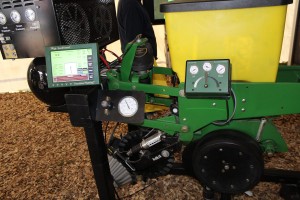LONDON, Ohio — In the medical field, a “prescription” is what determines the right amount of medicine each person should take, for each condition, and how many times a day.
Farmers are not in the medical field — usually — but thanks to new technologies and extensive sets of data — they can prescribe the best seed varieties and seed populations — directly from the seed company to the planter.
Prescription agriculture
This technology is often referred to as “prescription agriculture” and allows the farmer to match the best hybrids and populations, depending on the soil type, soil fertility, slope and terrain.
This was a popular topic among seed companies who attended the Farm Science Review, Sept. 16-18 in Madison County.
The prescription is based on data supplied by the farmer, state agencies and seed companies — and can be tailored to each field, and each acre.
“We’ve come to the point in time where there is enough computer power (and data) to start using that to build a prescription to be able to maximize the yield potential of hybrids,” said Travis Dollarhide, agronomy and product manager with LG Seeds.

His company expects to release a pilot program in 2015 to study the benefits of prescription agriculture, compared to the way planting is done today. He said a 4-6 bushel improvement will be needed to make the technology a success — which he expects will happen.
Same concept
While “prescription” is a fairly new term in the seed industry, the concept has infiltrated farm shows and field demonstrations for the past several years, as farmers continue to include precision, computer-based technology to improve yields.
“It’s been more of a concept and now it’s becoming more of a reality,” said Brad Miller, a technical agronomist with DEKALB.
He described it as matching the hybrid to the field.
“Every farmer has different soil types and so it’s not always the best thing to put one hybrid across that (whole) field,” he said.
Each seed company has its own brand name for the new technology — but it all centers around transferring seed variety and planting rate from the seed company, directly to the farmer or electronically to his planter.
Pioneer calls their program Encirca, which covers all things related to the soil, yield, seed selection and profitability.
Matt Miller, an Encirca Services business lead, said the goal is to “deliver whole-farm solutions to growers,” and to make the farmers’ data accessible in one place.
Whole-farm solutions
At the review, he showed farmers how Encirca helps farmers track nitrogen levels in their fields, from planting to harvest. This helps the farmer know when and where more needs to be applied, and helps prevent costly over-application.
Similar technology will be used to prescribe seeds and seed populations for different parts of the field, and Miller expects Pioneer will have more available on the prescription program into the fall and winter months.
Farmers will typically work with their seed sales representatives, to make sure they get connected with the kind of prescription programming they need.
Protecting data
A big issue will be data management — on both the farmer and seed company’s part.
Participation is voluntary, and seed companies are doing their part to ensure farmers of how the data will be used.
“We’ve got an upfront agreement with the farmer that shows how we would use the data, how everything would be processed and it lays everything out front,” said Justin Petrosino, an agronomist with Stewart Seeds.
Petrosino said the voluntary option should provide farmers some comfort. But at the same time, if they expect to benefit, they’ll need to participate.
“There has to be a level of trust,” said Dollarhide. “If a farmer expects to get some benefit from this, then you’re going to have to share some data — there’s no other way this can happen.”
Dollarhide said some farmers may be wondering why they should bother getting a prescription.
For instance, some may be able to track field conditions on their own, but others may have larger farms or may simply want the ease of a program that helps keep things more organized.
If that’s the case, then the prescription programs may make sense.










